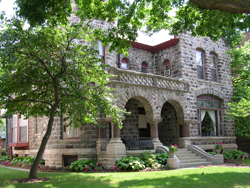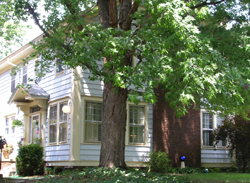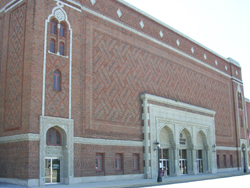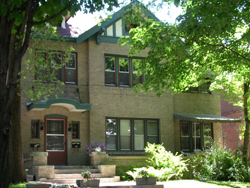
2004 Home and Garden Tour
Swinney
Homestead,
1424 W. Jefferson Blvd.
Prominent
local landowners Thomas and Lucy Swinney built their original Federal style
home in 1844 using native Indiana walnut, poplar, and limestone. Their daughters
remodeled the house in the Italianate style in 1886, adding the porch, the
paired brackets, and the central wall dormer that simulates an Italian tower.
The grounds became the Allen County Fairgrounds in 1874 and later became Swinney
Park. Settlers, Inc. has leased the home since 1983 and led in its restoration.
Jeremy Brames
Brian Stockman
904 West Berry Street
This eclectic example of a ColonialRevival-style house was built c.1907. Design details include a stepped up Flemish dormer, decorative brick and stone work, and two column styles on the front porch. Just inside the front doors are a beautiful entry hall and stairway.
George
and Pauline Jacobs, owners of the Union Bakery on East Main Street, first
owned the house. Chiropractors Ernest and Lily Lewellen purchased the home
in the early 1940s and practiced their business in the house for many years.
In 1995, the West Central Neighborhood Association saved the house from demolition
at its former sight on the southwest corner of East Main and Lafayette Streets
and moved it to its current site.
Owners Brian and Jeremy bought the house in 1999 and have undertaken many projects including updating the plumbing and electrical services, refinishing the wood trim including the front staircase, refinishing the wood floors and repairing plaster. The kitchen layout was revamped and the existing cabinets and hardware were refurbished.
The exterior has been cleaned and windows, trim and eaves have been painted. Restoration of the front porch included reproducing the original column capitals with the help of artists Cindy Husar and Allison Adams, and the woodworking craftsmanship of Jim Stockman, Brian's father. Jim repaired six of the original columns, fabricated three new columns, and reproduced all the molding and trim for the porch.
We hope that the Lewellen's would not only be happy with the Neighborhood's fight to save the house, but also with the restoration over the past 5 years.
Scott Francis,
Mike Knipstein, Mark Shank
1240 Stophlet St.
This
brick, cross-gable house was built c.1891 for Henry C. Kanning and his wife,
Sophia. It is primarily Queen Anne in style, detailed with curving eave supports
and scrolled roof brackets. The windows have stone lintels with a carved detail
and stone sills. The porch is a later version, as evidenced by the different
variety of brick and the square, tapered columns that are more indicative
of the Craftsman style.
Henry Kanning was born in Germany in 1859, and married Sophia (Wietfield) on June 12, 1890 in Allen County, Indiana. Early on, Henry worked as a bricklayer, then was a partner in a brick manufacturing company called Kanning and Hachmeier which was located on Illinois Road in Fort Wayne. Beginning in the 1920s, he ran his own mason contracting business called Kanning & Sons. Henry and Sophia lived here until their deaths in 1944 and 1942, respectively. Until 2001, the house had been owned by a member of the Kanning family.
Bob Bartrom
909 W. Main St.
This
wood-shingled, cross-gablehousewas built c.1865. The plain wood hood moldings
around the windows and door of the main façade are indicative of this
time period. The rear second story and wraparoundporch, with delicate round
support columns on tall, square bases, are additions from about the turn of
the twentieth century. Additional design details include transoms over the
front door and window.
David B. McClure and his wife, Jennie, lived here from about 1873 to 1900. After coming to Fort Wayne while still young, David made his living as a millwright for the Hoffman Brothers Saw Mill which was once located just across Main Street.
ARCH Inc.
918 Van Buren St.
Standing
as one of the oldest houses in the West Central neighborhood, this hall-and-parlor
house was built c.1840 for Frederick and Mary Rockhill-Tyler, descendents
of Fort Wayne pioneer William Rockhill. From about 1910 and up to 1997, when
restoration work on the house began, it was used as a garage.
The hall-and-parlor house plan, with only two rooms on the first floor, had
its roots in the British Isles. One room, the "hall," was a multi-purpose
room that was used for cooking, washing, and daily activities. The other room,
the "parlor," was used primarily as a reception room. The upper
floor of this house has three bedrooms with original woodwork. Restoration
work has included rebuilding the staircase and missing first-floor walls and
closets. New wallpaper, in patterns like those that were once on the walls,
has been applied.
ARCH, Inc., a local historic preservation organization, has coordinated the
on-going restoration of the house. It has been funded in part by a U.S. Department
of the Interior, National Park Service Historic Preservation Fund grant administered
by the Indiana Department of Natural Resources, Division of Historic Preservation
and Archaeology.
Klaehn, Fahl
& Melton Funeral Home
420 W. Wayne St.
This
Richardsonian Romanesque style house was designed by the architectural firm
of Wing & Mahurin in 1893 for Robert Bell, an attorney and state senator.
Contrasting smooth and rock-faced stone masonry on the exterior create a striking
effect. Other features include an open loggia above an entry porch with large
Syrian arches. On the west side of the house is a matching addition designed
by architect A.M. Strauss in 1935. While in existence as a residence, the
house boasted seven bedrooms, card room, billiard room, formal ballroom, and
library. Outstanding hand-carved and imported hardwoods compliment the interior
design.
Established in 1876 as Robert Klaehn & Sons, Klaehn, Fahl & Melton
is the oldest funeral provider in Fort Wayne. The Klaehn family bought the
residence in 1926 and converted it for use as a funeral home. Today, it serves
as the company's central location for funeral, cemetery and cremation services.
During the tour, antique funeral memorabilia and vintage professional automobiles
will be on display.
Glenn and
Cindy Ellenberger
721 W. Wayne St. - Garden and Carriage House Only
 Architects
Wing & Mahurin designed this house in the Richardsonian Romanesque style
in 1888. Architectural features include rough-cut granite walls and a variety
of arched openings, a round tower, and a parapeted gable. The arcaded porch
is supported by short columns of polished granite and topped by stone laid
in a checkerboard pattern.
Architects
Wing & Mahurin designed this house in the Richardsonian Romanesque style
in 1888. Architectural features include rough-cut granite walls and a variety
of arched openings, a round tower, and a parapeted gable. The arcaded porch
is supported by short columns of polished granite and topped by stone laid
in a checkerboard pattern.
The house was built for L.O. Hull who ran a wholesale and retail wallpaper business on South Calhoun Street. Hull, a native of Richland County, Ohio, was a Civil War veteran, serving in the Union army with Company B, One Hundred and Twenty-ninth Ohio Infantry until 1865. He died at the age of 80 in 1929.
The current owners recently built a carriage house designed
to complement the historic architecture of the house and have created a beautiful
backyard garden to enhance the overall effect.
West Central
Arts Fest
918 W. Berry St. - rear gardens
West Central is special for reasons in addition to its distinctive homes. Adding to the character of the neighborhood is its abundance of gifted and creative residents. We invite you to step under the trees and enjoy a sampling of West Central's visual and performing artists. Take time to browse and speak with each of them as they demonstrate their particular craft, but also have a seat and enjoy jazz, classical violin, folk music, acoustic guitar and lively Broadway show tunes as our musicians perform throughout the day.
Our visual artists this year include four new faces: Karen Moriarty, Matt Presswood, Teri Marquart and Amber Bennett. Returning artists include Diane Groenert, Cindy Husar, Laura Stewart and Alice Goodland. On stage, returning for his third year, is classical violinist Jesse Hawkins. On Sunday, Jesse will also join in with the band The Distractions. New this year will be performances by Melissa Junkin, a veteran of both the Civic and Arena Dinner theaters, and Lori Platt from IPFW's Department of Theatre.
So, stop by and take time to enjoy another facet of what makes the West Central neighborhood so special!
Larry Wardlaw
1232 W. Wayne St.
 This
Colonial Revival-style housefeatures double-hung, multi-paned windows and
a pedimented, centered side-entry portico flanked by pilasters.
This
Colonial Revival-style housefeatures double-hung, multi-paned windows and
a pedimented, centered side-entry portico flanked by pilasters.
The house was built in 1924 for William and Ada Rabus. William was a local tailor, which is likely the reason that so many large closets were built in the house! In the in the 1940s, the house functioned as a small boarding house. In the mid-1950s, John and Dorothy Escosa moved in and raised their four children here. They also founded the Fort Wayne Ballet in the living room! Dorothy, an accomplished pianist, taught lessons here, and John was a nationally recognized harpist who traveled on tour.
Scottish
Rite Center
431 W. Berry St.
 Guy
Mahurin, local architect and Shriner, designed the Spanish Eclectic style
Scottish Rite Center in 1924. Architectural elements common to this style
include the arched doors and windows, with the main doors being emphasized
by adjacent columns. This building also features elaborate brick patterns
and decoratively carved stonework. The interior design exhibits Moorish influences
and has undergone recent significant rehabilitation.
Guy
Mahurin, local architect and Shriner, designed the Spanish Eclectic style
Scottish Rite Center in 1924. Architectural elements common to this style
include the arched doors and windows, with the main doors being emphasized
by adjacent columns. This building also features elaborate brick patterns
and decoratively carved stonework. The interior design exhibits Moorish influences
and has undergone recent significant rehabilitation.
Costing over one million dollars to construct, the building opened in 1925. Early events held here included performances by actresses Eve Arden and Mae West. Later acts included Betty Grable, Eileen Brennan, and George Jones and Tammy Wynette. Recent events have showcased such things as local dance talent, theater productions, the Purdue University Glee Club and singer Ani DiFranco.
You are welcome to just stop in and look around at your leisure, or guides will be available for half-hour tours of the facility if you so choose.
Rhonda and
Bernie Gump, owners
1223 W. Wayne St.
 Architect
Alvin M. Strauss, designer of Fort Wayne's Lincoln Tower and Embassy Theatre,
designed this duplex for David and Lottie Frosh, their son Henry and his wife
Sylvia. David and Henry owned Frosh's Clothing House, a men's clothing store
located on East Main Street. David began the store in 1901 and continued to
operate it until his death in 1933.
Architect
Alvin M. Strauss, designer of Fort Wayne's Lincoln Tower and Embassy Theatre,
designed this duplex for David and Lottie Frosh, their son Henry and his wife
Sylvia. David and Henry owned Frosh's Clothing House, a men's clothing store
located on East Main Street. David began the store in 1901 and continued to
operate it until his death in 1933.
The architecture of the house, built c.1923, includes a mix of styles. The Craftsman style is evident by the thick brackets supporting the front and side gable roofs and by the details in the upper-story windows. Tudor details are apparent in the steeply-pitched gable dormers and by the patterned brick detail over the center windows on the lower level, over the main entrance, and between the upper and lower levels. The decorative half-timbering of the front and side gables is a common element of both design styles. The colorful awnings are a recent and pleasant addition to the structure.
Barbara
and Larry Codding
1123 W. Wayne St.
This
Queen Anne-style house was built c.1889 for Joseph W. Bell. Common style details
may be seen in the complicated roofline and the two-story tower on the east
side of the main façade. The spindlework detail between the second
floor windows of the tower is another Queen Anne element. The original front
porch was rounded and extended from the house at the tower area. The current
front porch, with square, tapered columns and balustrade with square balusters,
is characteristic of 1920s porch construction. Prior to being turned into
a duplex in about 1940, the main entrance to the house was at 1125 W. Wayne
Street. Note the transom over the window that still displays "285"
which was the address of the house under a former numbering system.
Joseph W. Bell was born in Ohio in 1853 and came to Fort Wayne in about 1884. From about 1886 to 1911, he operated a saddlery hardware store on The Landing on E. Columbia Street. He then entered the real estate business. He died in 1934.